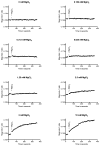Plasma magnesium is inversely associated with Epstein-Barr virus load in peripheral blood and Burkitt lymphoma in Uganda
- PMID: 29248801
- PMCID: PMC5785547
- DOI: 10.1016/j.canep.2017.12.004
Plasma magnesium is inversely associated with Epstein-Barr virus load in peripheral blood and Burkitt lymphoma in Uganda
Erratum in
-
Erratum to "Plasma magnesium is inversely associated with Epstein-Barr virus load in peripheral blood and Burkitt lymphoma in Uganda" [Cancer Epidemiol. 52 (2018) 70-74].Cancer Epidemiol. 2018 Aug;55:192. doi: 10.1016/j.canep.2018.05.010. Epub 2018 Jun 1. Cancer Epidemiol. 2018. PMID: 29861403 No abstract available.
Abstract
Background: Epstein-Barr virus (EBV) causes endemic Burkitt lymphoma (eBL). EBV control was improved by magnesium (Mg2+) supplementation in XMEN, an X-linked genetic disease associated with Mg2+ deficiency, high circulating EBV levels (viral loads), and EBV-related lymphomas. We, therefore, investigated the relationship between Mg2+ levels and EBV levels and eBL in Uganda.
Methods: Plasma Mg2+ was measured in 45 women with low or high circulating EBV levels, 40 pediatric eBL cases, and 79 healthy children. Mg2+ uptake by T-lymphocytes was evaluated in samples from healthy donors.
Results: Plasma Mg2+ deficiency (plasma level <1.8 mg/dl) was more likely in women with high- vs. low-EBV levels (76.0% vs. 35%; odds ratio [OR] 11.3, 95% CI 2.14-60.2), controlling for age, and in eBL cases than controls (42.0% vs. 13.9%; OR 3.61, 95% CI 1.32-9.88), controlling for sex, age group, and malaria status. Mg2+ uptake by T-lymphocytes was related to extracellular Mg2+ concentration.
Interpretation: Plasma Mg2+ deficiency is associated with high EBV levels and eBL.
Keywords: Africa; Burkitt lymphoma; Epidemiology; Epstein-Barr virus; Magnesium; XMEN.
Published by Elsevier Ltd.
Conflict of interest statement
None declared
Figures


References
-
- Parkin DM, Sitas F, Chirenje M, Stein L, Abratt R, Wabinga H. Part I: Cancer in Indigenous Africans--burden, distribution, and trends. The lancet oncology. 2008;9:683–92. - PubMed
-
- Tsai MH, Raykova A, Klinke O, et al. Spontaneous lytic replication and epitheliotropism define an Epstein-Barr virus strain found in carcinomas. Cell reports. 2013;5:458–70. - PubMed
-
- Hjalgrim H, Askling J, Rostgaard K, et al. Characteristics of Hodgkin’s lymphoma after infectious mononucleosis. N Engl J Med. 2003;349:1324–32. - PubMed
Publication types
MeSH terms
Substances
Grants and funding
LinkOut - more resources
Full Text Sources
Other Literature Sources

